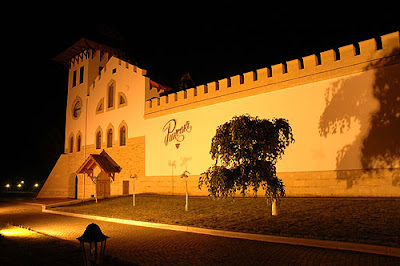Milestii Mici is a wine factory and wine collection of Moldova situated 20 km south of Chisinau near a village with a similar name. Its underground wine city in limestone is stretching for 250 km of which 120 km are currently in use. Milestii Mici cellar complex is recognized to be the largest in the world. Tunnel streets "Cabernet", "Shardonait", "Feteasca", "Sauvignon" etc. form a transport web of the wine city. One need a car to drive from one part of the winery to the other and it's not rare to see its employees traveling from one workshop to another by bicycle.
It's chilly and dark in the cellar. Being situated deep under the ground (40-85 meters deep) the temperature inside the lime galleries stay constant all year around (at 12 - 14 C and the humidity of 85 - 95%) being ideal for storage and preserving of its wines. Don't forget to take a warm jacket when you come on a tour even if it's plus 40 Centigrade outside. It's always cool and chilly underground!!!
The "Golden Collection" of Milestii Mici holds nearly 2 million bottles and was recently recognized as Europe's largest wine collection by Guinness World Records. More than 70% of the stored wines are red, 20% are white and about 10% are dessert ones. The most valuable items of this collection, worth EURO480 a bottle, were produced in 1973-74; they are now exported only to Japan. The wines stored here are made from crops of various years, beginning with 1969: "Pinot", "Traminer", "Muscat", "Riesling", "Feteasca", "Dnestrovscoie", "Milestscoie", "Codru", "Negru de Purcari", "Trandafirul Moldovei", "Auriu", "Cahor-Ciumai", and others. All these wines are made according to the old Moldavian traditions; you can fell the sunshine and the power of the earth in every drop of it.
During the tour the guide will tell you about the history of Milestii Mici and the wine industry of Moldova, its past and present, take you through the wine collection showing the rare samples and explain how to store the bottles correctly to keep its original flavour and bouquet untouched, take your through the collection of champagne and tell you the secrets of its production and finally taking you to the festive part of the winery, tasting rooms.
The tour ends with tasting of wines accompanied by snacks or a traditional Moldovan lunch. Tasting rooms are well decorated in a traditional Moldovan style. Warm color of oak tables, chairs and sculptures combined with cold stone walls of the rooms form an authentic feeling of a Moldovan wine cellar. Moldovan traditional band of "Lautari" will perform Moldovan folk songs, as well as well known international plays on violin and accordion while you are tasting red and white wines from the local collection. Your guide will be introducing each bottle of wine telling the favors that you should taste with each kind of wine. After the "theoretical" part will be let to relax and enjoy the wine, food and music!!!
There is a company shop on the territory of the wine complex and those of you who didn't get some bottles of wine as a souvenir, can purchase more bottles of favorite wine in this shop.
The most popular tours at Milestii Mici are:
„Butoias” : tasting of ordinary wines from the barrel with appetizer (dried fruits, kernel, biscuits). Duration ~ 1,50 h
„Express” : tasting of 3 types of wine (1 ordinary wines, 1 high quality wines, 1 sparkling wine) with meal (appetizer „Doina”, assortment of salami, chicken barbecue with pineaple, french fries, fruits) + 1 bottle of white ordinary wine and 1 bottle of red high quality wine as a souvenir. Duration ~ 2 h
„Classic” : tasting of 7 wines (2 high quality wines, 4 collection wines, 1 sparkling wine) with meal (appetizer „Doina”, salami assortment, pie assortment, chicken fillet, mash potatoes, fruits) + 1 bottle of white high quality wine and 1 bottle of white sparkling wine as a souvenir.
Duration : ~ 2 h
„National” : tasting of 7 wines, (2 high quality wines, 4 collection wines, 1 sparkling wine) with meal (baked vegetables, assortment of fresh vegetables, cheese, assortment of meat, pickles, "mamaliga" with pork casserole, "galusi", fruits, plums with nut) + 1 bottle of stored in collection wine and 1 bottle of white sparkling wine as a souvenir. Duration: ~ 2.30 h
Our guests' tips & feedback:
"Trip to Milestii Mici was really quite stunning. Well worth the money. Only one tip to visitors like us is for them to remember that you won’t be able to carry wine in hand luggage. We had to move our bottles into our main case at the airport. Luckily they survived back to the UK intact."
"The tour we went on to Milestii Mici was both interesting and fun"
"The Milestii Mici wine tour was fantastic, an awsome place, with nice wine tasting and food afterwards. "
source: marisha.net












































